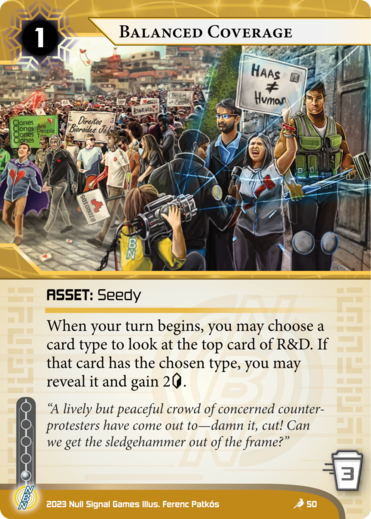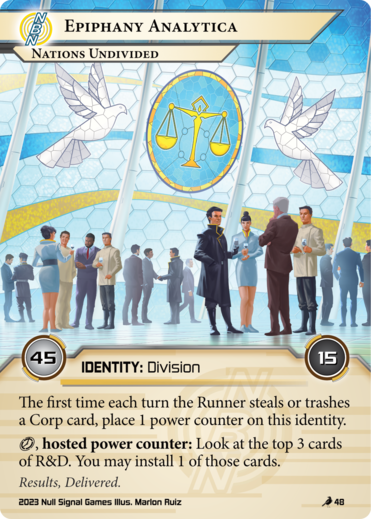Designing identity cards is both one of the most important parts of each set and the most difficult to get right. Your ID is the most impactful card in every deck – it’s the one card you are guaranteed to see in every game. And since you can only play one ID in each deck, the competition between identities is much steeper than for any other type of card. This means identities require a ton of attention to get right, both in terms of interesting game play and power level balance.
In a typical set, we have two main goals for each new ID. First, supporting the set’s other new cards. Second, finding a niche for the new ID among the existing IDs in that faction. These goals don’t always support each other, but finding a design that can succeed at both is crucial to a set’s design.
Broadly speaking we want at least 60% of the new cards for each faction, including the ID, to be synergistic enough to fit into the same deck. This ratio provides a solid foundation of self-supporting cards for each ID’s time in Standard and Startup. It also makes it easier for those with incomplete collections to build decks. To find a niche for each new ID, we try to design them to support different gameplay patterns, or to work best with cards other than the staples used by other IDs in the faction.
So how did we arrive at the niche for Epiphany Analytica? NBN’s cards in the Liberation Cycle are primarily built around predicting the cards on top of R&D or collecting information about the top of R&D. Today’s first preview card is one of the former kind:
Balanced Coverage is a perfect example of what NBN represents in this set, infusing the theme of controlling the flow of information into the gameplay. Just as the news team depicted in art and flavor text has a very specific narrative to tell, the Corp using Balanced Coverage tells the Runner what they want the top card to be and will only show it off if they are right. And this information sharing dynamic extends out past the moment the effect is triggered. Before using Balanced Coverage, the Corp will be using the Runner’s actions when they access R&D to figure out what kind of card could be on top. Afterward, the Runner will want to remember what the Corp revealed so they avoid being surprised later.
So what ID ability does this asset synergize with? One early proposal for an ID to fit this R&D information theme was this design:
This was as close to “You may look at the top card of R&D at any time” as we could reasonably print without creating tricky timing and rule headaches. This effect is deceptively powerful even without the supporting cards in the set — knowing what is sitting on R&D going into the Runner’s turn is a powerful tool for informing your decisions. In terms of our main goals, it does support the cycle’s primary theme for NBN — with the caveat that it makes the prediction effects a bit too simple — but it wasn’t going to compete well with existing NBN IDs without adding an entire second ability. So we kept searching for a better design.
Since the set synergy-first approach didn’t bear fruit, next we looked at a design with an ability that was high impact when used but happened less frequently:
This design does double duty, providing knowledge of what’s on top of R&D while also acting as a powerful tool to further your gameplan. The restriction “only if the Runner trashed or stole one of your cards last turn” is a clause we have used on cards in the past, but it has some player memory issues and can create confusion alongside effects that are similar but not exactly the same. Playability concerns aside, however, this effect definitely got high marks for working well with the rest of the set. As for finding a niche for the ID, we felt it could certainly compete with other NBN IDs — in fact, we had concerns that the action might be too generically powerful and could push other IDs out of playability. The flexibility of getting to draw or install one of the looked-at cards meant it didn’t ask interesting questions of deck builders.
Having gone through these designs — one simple, one high power — we came up with a version that kept the good parts of the last idea but cleaned up the memory issues and specialized the effect. That version was pitched, tested, and survived almost totally unchanged to the final card!
Usually we expect to at least see a tweak to the numbers after we settle on a basic design, but Epiphany Analytica survived with only minor changes for rules clarity. Using power counters to track when the Runner stole or trashed a card and to fuel the second ability really tied the room together in terms of memory and flexibility. We also let the effect go one card deeper, but took away the option of adding a card to HQ instead of installing. This simultaneously makes the effect more proactive and less generically good, meaning deckbuilders will need to consider running fewer operations in order to maximize the ID ability.
I hope you have enjoyed this abbreviated look at how identities change and evolve in the design process. Please look forward to the rest of preview season!


